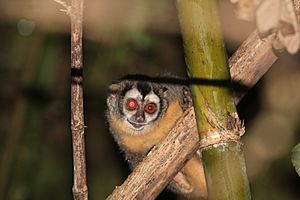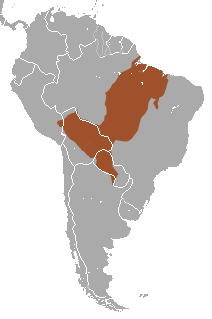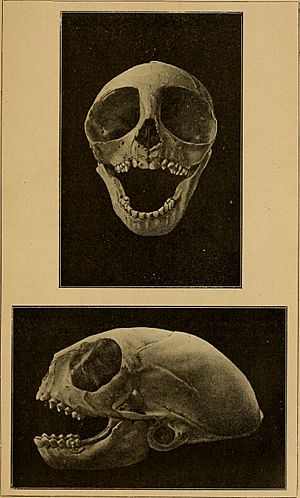Azara's night monkey facts for kids
Quick facts for kids Azara's night monkey |
|
|---|---|
 |
|
| Azara's night monkey (A. a. infulatus) at Cristalino Jungle Lodge, Mato Grosso, Brazil | |
| Conservation status | |
| Scientific classification | |
| Genus: |
Aotus
|
| Species: |
azarae
|
 |
|
| Azara's night monkey range | |
The Azara's night monkey (Aotus azarae) is also known as the southern night monkey. It's a type of night monkey that lives in South America. You can find these monkeys in countries like Argentina, Bolivia, Brazil, Peru, and Paraguay.
These monkeys are special because they are monogamous. This means a male and female monkey usually stay together for life. The male monkey also helps a lot with raising their babies. The Azara's night monkey is named after Spanish naturalist Félix de Azara.
Most night monkeys are only active at night. But some Azara's night monkeys are unique! They are active both during the day and at night. This species is currently listed as Least Concern on the IUCN Red List. This means they are not considered to be in danger of disappearing.
Contents
About Azara's Night Monkey
What are Subspecies?
Animals can have different types within the same species. These are called subspecies. They might look a little different or live in different places. There are three known subspecies of Azara's night monkey:
- Aotus azarae azarae
- Bolivian night monkey, Aotus azarae boliviensis
- Feline night monkey, Aotus azarae infulatus
How Big Are They?
Scientists don't have a lot of exact measurements for Azara's night monkeys in the wild. But they have made some good guesses!
An adult female monkey is about 34 centimeters (13 inches) long. An adult male is slightly longer, at about 34.6 centimeters (13.6 inches). They weigh around 1.2 kilograms (2.6 pounds).
Baby Azara's night monkeys grow inside their mother for about 133 days. That's about four and a half months! We don't know exactly how long they live in the wild. But other types of night monkeys in zoos can live for up to 20 years.
Life in the Wild
Family Life and Behavior
Azara's night monkeys are monogamous. This means they form a strong pair bond and stay with one partner. The male monkey plays a very important role in raising the babies. He helps carry them and finds food for them.
Young monkeys stay with their family until they are about two or three years old. Then, they leave to find their own partner and start a new family. It can be hard to tell male and female Azara's night monkeys apart. They look very similar!
What Do They Eat?
Azara's night monkeys mainly eat fruit. This makes them frugivores. But they also enjoy other foods like leaves, flowers, and insects. Being active at night helps them find food. There are fewer other animals looking for food at night, so there's less competition!
Where Do They Sleep and Play?
These monkeys spend their whole lives up in the trees. They move around more when the moon is bright. They often use the same paths through the trees that they know well.
Most night monkeys are only active at night. But some Azara's night monkeys, especially those living in the Gran Chaco area, are active both day and night. This is very unusual for night monkeys!
Azara's night monkeys usually sleep in groups of 2 to 5 in trees. An average group has about 3 monkeys. This usually includes an adult pair and their babies. They can leap from tree to tree. They also move on all four limbs, which is called quadrupedalism, as they walk through the forest.
Where They Live
Their Home and Habitat
Azara's night monkeys live in northern Argentina, Bolivia, central Brazil, Paraguay, and the far southeastern part of Peru. Their home includes the southern Amazon. They also live in more open areas like the Gran Chaco.
Different subspecies prefer different types of forests:
- Aotus a. azarae lives in gallery forests (forests along rivers) and semi-deciduous forests (where trees lose some leaves).
- A. a. infulatus prefers humid lowland forests and gallery forests.
- A. a. boliviensis can be found in many different forest types. This subspecies has even been seen high up in the Andean foothills, at about 1,250 meters (4,100 feet) above sea level!
Keeping Them Safe
Azara's night monkeys are found across a wide area. They are generally quite common. They also live in several protected areas. So, they are not considered to be in danger of extinction right now. However, in some local areas, their numbers are going down. This is mainly because their forest homes are being lost.
See also
 In Spanish: Marikiná de Azara para niños
In Spanish: Marikiná de Azara para niños



